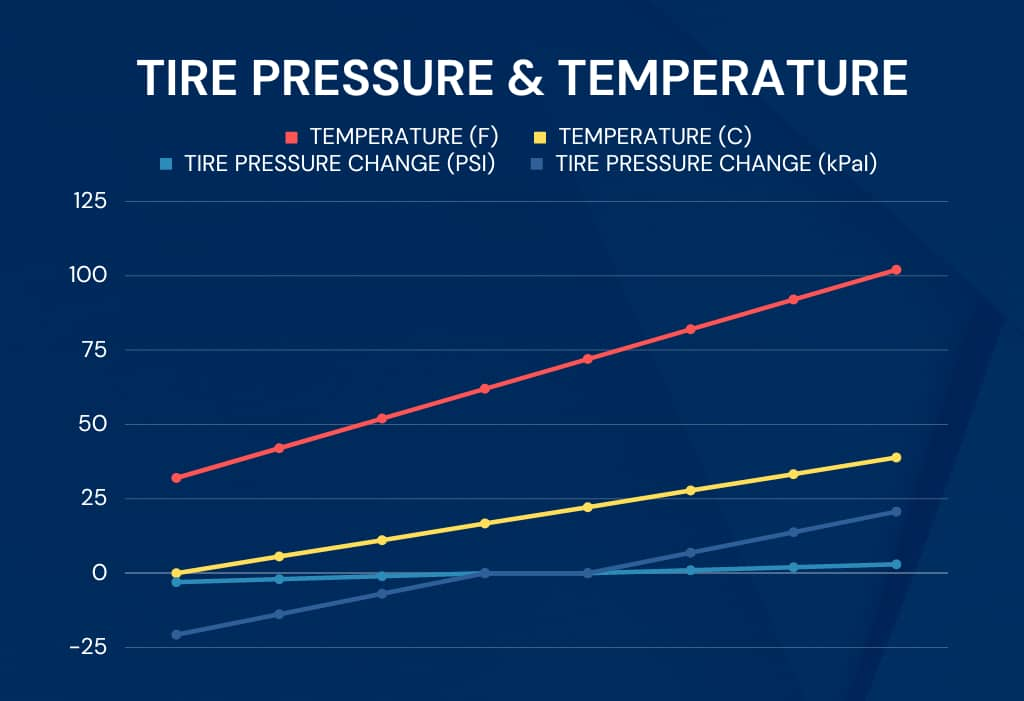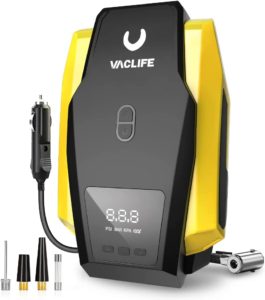Steps to Reset Hyundai Elantra Tire Pressure Light
Step 1: Check and Adjust Your Elantra Tire Pressure
The Hyundai Elantra doesn’t have a specific button for resetting the tire pressure. To switch off the tire light, you need to make sure all four tires have the right amount of air in them. You can find the proper pressure by checking the sticker on the driver’s side door frame, looking at the chart below, or using the Mode button on your steering wheel to go to the tire pressure screen. Be sure to fill each tire to the exact recommended pressure. It’s crucial that you adjust the tire pressure when the tires are cold, which means they haven’t warmed up yet. This is typically before going on long trips or after your car has been sitting for a few hours.
Step 2: Drive Your Elantra
After you’ve inflated your tires to the recommended cold pressure, take your Elantra for a ride. Drive for a few minutes at speeds over 20 mph. You might see a message on your dashboard LCD saying “drive to display.” As you continue driving, the tire pressure light should turn off and your tire pressures will display on the LCD. If it doesn’t disappear immediately, just keep on driving for another few minutes.
Step 3: Re-Check Your Tire Pressure
If the tire pressure light is still on after doing steps 1 and 2, make sure to double-check the tire pressure to confirm they’re at the exact level you set them to. If they’re not, there could be a leak in the tire or valve stem, or maybe even a puncture. If the tire light goes off after inflating the tires but then turns back on, it’s likely that you have a tire leak. And if the tire pressure light blinks or flashes before staying on, it means there’s a problem with your tire pressure system. Keep reading below if your tire light is flashing.
2023 Hyundai Elantra Tire Pressure
Match your tire size to the chart below:
Tire Size | FRONT PSI | FRONT PSI |
195/65R15 | 34 | 31 |
205/55R16 | 34 | 31 |
225/45R17 | 34 | 31 |
235/40R18 | 33 | 33 |
SPARE TIRE | 60 | 60 |
Hyundai Elantra TPMS Malfunction Indicator
The Hyundai Elantra’s tire pressure monitoring system (TPMS) includes a built-in malfunction indicator. This indicator uses the same yellow exclamation point tire warning light as the low pressure warning. If the TPMS runs into a problem, the warning light (yellow exclamation point) will flash for about a minute before staying on. This flashing pattern will repeat each time you start your car until the issue is fixed. It’s important to realize that while the indicator is active, the TPMS may not function properly. This means your tire pressure monitoring system won’t work as intended until you resolve the TPMS problem. In other words, a blinking tire pressure light signals an issue with the TPMS itself, usually a defective pressure sensor in one of your tires, rather than an actual air pressure issue.
To figure out which tire sensor is causing the issue, you’ll need a TPMS diagnostic tool, like the Autel TPMS tool. (I’ve been using Autel TPMS diagnostic tools for a couple of years, and I highly recommend them.)
Reset Your TPMS in these Cases:
After adjusting tire pressure to the recommended levels
After tire rotation, wheel balances, wheel alignments, or tire replacement
When a TPMS sensor has been replaced or serviced
After putting on a new wheel/rim or changing tire size
If the vehicle’s battery has been disconnected, swapped out, or jumped
When the TPMS malfunction indicator is activated
Seasonal shifts that could impact tire pressure due to changes in temperature. (read more on this below)
How the Hyundai Elantra TPMS Works
The Hyundai Elantra’s tire pressure monitoring system (TPMS) aims to maintain the ideal tire pressure, improving both safety and fuel efficiency. Here’s an in-depth look at its operation:
Direct TPMS: The Hyundai Elantra employs a direct TPMS, which means it features pressure sensors within each tire that constantly track your tire pressure levels.
Wireless Communication: These sensors wirelessly send tire pressure information to the car’s onboard computer, enabling real-time monitoring.
Tire Pressure Display: You can view the TPMS data through the vehicle’s LCD display system, which shows the current pressure of each tire.
Low Pressure Alert: If the pressure in any tire drops below the recommended level, the TPMS activates a warning light (a yellow exclamation point) on the dashboard to notify the driver. (Usually anything below 15% the recommended pressure will set off the light)
Malfunction Indicator: The TPMS also incorporates a malfunction indicator that utilizes the same warning light. If the system experiences an issue, the light will flash for approximately a minute before staying on. This sequence will recur every time you start your car until the problem is fixed.
Sensor Battery Life: The battery-powered TPMS sensors generally last between 5 and 10 years. A low or depleted battery will trigger the malfunction indicator.
Seasonal Adjustments: The TPMS can detect significant tire pressure changes due to seasonal temperature variations, ensuring that tires maintain optimal pressure levels throughout the year.
What Causes Your TPMS Light to Turn On?
The Hyundai Elantra TPMS light can illuminate for a variety of reasons, indicating potential problems that need attention. Here’s a complete list of possible causes:
Low Tire Pressure: The most frequent cause of the TPMS light activation is when the pressure in one or more tires falls below the recommended level. This can happen due to a slow leak, puncture, or gradual pressure loss over time.
TPMS Malfunction: If the TPMS itself encounters an issue, the warning light will flash for around a minute and then remain on. This might result from a defective sensor, a dead or weak sensor battery, or communication problems between the sensor and the car’s computer.
Seasonal Changes: Temperature fluctuations can lead to changes in tire pressure. This is VERY common. Cold weather typically causes a drop in tire pressure, while warmer temperatures can lead to increased pressure. The TPMS light will activate when significant pressure changes happen due to seasonal temperature variations. (read more on this below)
Tire Rotation or Replacement: The TPMS light may turn on after a tire rotation or replacement if the system needs resetting or if the tires haven’t been inflated to the correct pressure. Sometimes after a tire rotation, the vehicle computer might think the rear tires are in the front or visa-versa, this is why it’s essential to reset your tire pressure system.
New Wheel or Tire Size Installation: If you’ve installed new wheels or changed tire sizes, the TPMS light might come on if the system hasn’t been recalibrated to accommodate the changes. This can also be an issue if you replace a wheel/rim without transferring sensors from the old wheel to the new one.
Disconnected or Replaced Vehicle Battery: The TPMS light could be triggered if the car’s battery has been disconnected or replaced, as this might require the system to be reset.
Sensor Damage: Physical damage to a TPMS sensor, such as from an impact, corrosion, or improper installation, can cause the TPMS light to activate. I have seen many instances where the rubber gasket between the valve and sensor goes bad, causing a leak. The rubber gasket can be replaced without having to change the entire sensor.
Spare Tire: Hyundai Elantra spare tires do not have sensors so when you have your spare on, your tire light will stay on.
How Air Temperature Affects Tire Pressure
The chart displayed above demonstrates the relationship between air temperature and tire pressure. It indicates that as the temperature outside decreases, tire pressure will drop, while an increase in temperature causes tire pressure to rise. A useful benchmark to remember is approximately 62°F (16.7°C), as this is the temperature at which tire pressure typically remains stable. Therefore, for every 10-degree decrease in air temperature, your tire pressure will reduce by roughly 1 PSI.
Benefits of TPMS in Hyundai Elantra
Enhanced Safety: The TPMS alerts you when tire pressure falls below the recommended levels, reducing the risk of tire failure, blowouts, and accidents while driving.
Improved Fuel Efficiency: Properly inflated tires help ensure optimal fuel efficiency, which can save you money on gas and reduce your vehicle’s carbon footprint.
Extended Tire Life: By maintaining the correct tire pressure, the TPMS helps you maximize tire lifespan, preventing premature wear and tear.
Better Driving Performance: Proper tire pressure contributes to improved handling, braking, and overall driving performance, making your driving experience smoother, safer, and generally just better.
Reduced Environmental Impact: By promoting fuel efficiency and tire longevity, the TPMS indirectly helps minimize waste and emissions, contributing to a greener environment.
Early Leak Detection: The TPMS can help identify slow leaks or punctures before they become major issues, allowing you to address the problem promptly and avoid more extensive damage.
Peace of Mind: With the TPMS constantly monitoring your tire pressure, you can have greater confidence that your tires are in good condition, allowing you to focus on enjoying your drive.
In summary, the Hyundai Elantra TPMS helps create a safer, more fuel-efficient, and comfortable driving experience by ensuring that your tires have the right amount of pressure and notifying you of any potential problems.
In Conclusion
Resetting the tire pressure warning light on a 2022 Hyundai Elantra is a simple task that can be done by following a few steps. By adhering to the instructions provided in this article, you can ensure that your tire pressure monitoring system works accurately, and your Hyundai Elantra delivers optimal performance. Be sure to check your tire pressures at least once a month and before taking any trips!
Please note that this blog post contains Amazon affiliate links. This means that if you make a purchase through one of these links, we at TPMSRESET.com may earn a small commission at no extra cost to you. We only recommend products that they personally use and believe in. Thank you for supporting this blog.



